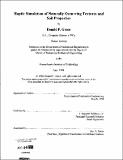Haptic simulation of naturally occuring textures and soil properties
Author(s)
Green, Donald F. (Donald Frederick), 1969-
DownloadFull printable version (4.094Mb)
Advisor
J. Kenneth Salisbury, Jr.
Terms of use
Metadata
Show full item recordAbstract
Methods for developing realistic haptic (force feedback) simulations of soils and rocks are presented. Mathematical models of the dynamics of a virtual probe mechanically interacting with a virtual object are developed to provide the basis for analysis and simulation. The models then incorporate stochastic inputs in order to provide the haptic simulations with a more natural, less synthetic feel. The stochastic input parameters are derived by analyzing actual force data sensed while probing a subject media with the haptic display itself; in this case used as a force controlled manipulator. A method for sensing friction properties of rigid, textured surfaces and using the data collected to drive a realistic haptic texture simulation is presented. Static friction coefficients and surface height deviations a e sensed by directly stroking the surface under examination with a probe fitted on the end of a PHANToM haptic display device. Test surfaces range from pieces of sandpaper of varying coarseness to acetate. A simulation of the texture may then be rendered using the mechanical model of textured surface-probe interaction augmented by statistical variation of the friction properties of the surface. An algorithm is presented for adding texture properties to three-dimensional object models. The method is based on determining surface normals of the virtual object and assigning statistically varying friction properties and surface height deviations to area patches on the object's surface using the methods described above. Finally, a dynamic model of probe/soil interaction is used to render a haptic simulation of loose grained soils such as sand. Certain friction properties are again statistically varied in order to improve the realism of haptic display user's experience.
Description
Thesis (S.M.)--Massachusetts Institute of Technology, Dept. of Mechanical Engineering, 1998. Includes bibliographical references (p. 69-71).
Date issued
1998Department
Massachusetts Institute of Technology. Department of Mechanical EngineeringPublisher
Massachusetts Institute of Technology
Keywords
Mechanical Engineering